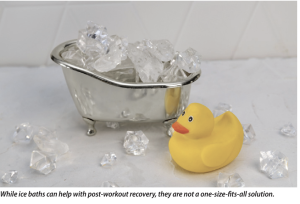Are ice baths really that good for you?
Learn the benefits and risks before trying Ice baths are growing in popularity.
They can help with post-workout recovery, reduce muscle soreness and promote overall well-being. But anyone who wants to try this at home or elsewhere should understand what a cold-water dip or bath does to the body and weigh the benefits and risks and the importance of safety. Ice baths involve immersing one’s body or specific body parts in icy water, typically in temperatures ranging from 50 to 59 degrees, for a brief period.
The practice of cold-water therapy dates back many centuries. Their resurgence in popularity can be attributed to endorsements by professional athletes and celebrities. Pro athletes use ice baths to aid in their recovery after intense workouts or competition. Others tout ice baths for other potential benefits, including mental and immune health and chronic pain relief. So, are ice baths good for everyone? While ice baths can help with post-workout recovery, they are not a one-size-fits-all solution. 
Their overall benefits are still being studied. In general, they are not harmful, but they are not meant for everyone.
“People with pre-existing health conditions, such as diabetes or heart issues, should check with their doctor before attempting ice baths to ensure their safety,” says Alex Crane, MD, a family medicine physician with expertise in sports medicine and injury treatment at Scripps Clinic Del Mar.
What are the benefits of ice baths? Ice baths offer both proven and potential benefits, including: Relieves sore muscles Ice baths, or cold-water immersion, promote faster recovery from sore muscles and reduced muscle fatigue after intense exercise. The icy water can help flush out metabolic waste products and decrease muscle soreness after intense workouts. This then leads to reduced muscle soreness and increased post-exercise comfort. Reduces inflammation The cold temperature of ice baths causes blood vessels to constrict, which can help decrease swelling and inflammation in the muscles and joints.
This is especially beneficial for athletes looking to expedite the healing of minor injuries or strains. Improves mood Ice baths are believed to stimulate the release of mood-lifting brain chemicals. This natural mood lift contributes to an enhanced sense of well-being and relaxation. Arthritis management People with arthritis may find relief through cold water immersion. It can help alleviate joint pain and reduce inflammation, providing temporary respite from the discomfort associated with this condition. What are risks and side effects? While ice baths offer potential benefits, they also come with risks and side effects, including: Hypothermia Prolonged exposure to chilly water can lead to hypothermia, a dangerous drop in core body temperature.
This risk highlights the importance of sticking to recommended immersion times and temperatures. Keep in mind, older adults are more sensitive to cold than younger adults. Cold shock response Sudden immersion in icy water can shock the body. This can result in rapidly increased breathing, heart rate and blood pressure. The initial shock of the cold can also be dangerous as it can increase the risk of drowning if you’re in deep water. Cardiovascular stress Ice baths can put stress on the cardiovascular system. They may not be suitable for people with certain heart conditions. Caution taking ice baths at home Ice baths can be done at home or in a chilly lake or at places that offer cold-water therapy supervised by trained professionals. If you want to try this at home in the safest way possible, check first with your doctor, especially if you have an injury or health condition.
There are no official recommendations for taking an ice bath but studies suggest that staying in cold water for 5 to 15 minutes offers results. At home, you’ll need a bathtub or an immersion tub, cold water, ice, a thermometer to monitor water temperature and a timer. Staying in the tub can be difficult so start small with 2 to 5 minutes and slowly increase your time in an ice bath. Make sure to have warm towels and clothes ready when you emerge. Proper equipment and caution ensures a safe and effective experience. It’s crucial to pay close attention to your body’s response during an ice bath.
“If you experience excessive discomfort, numbness or any adverse reactions, exit the bath promptly,” Dr. Crane says. “Safety should always be the top priority.” Alternatives to ice baths It’s important to note that ice baths are not the only option for post-workout recovery.
So before starting any new recovery method, including ice baths, contrast baths or compression therapy, consult with your doctor. “What works best for you may depend on your fitness level, health status and personal preferences,” Dr. Crane says.
We are currently experiencing a power outage.
We expect the power to be restored at 3PM PDT.
We expect the power to be restored at 3PM PDT.
